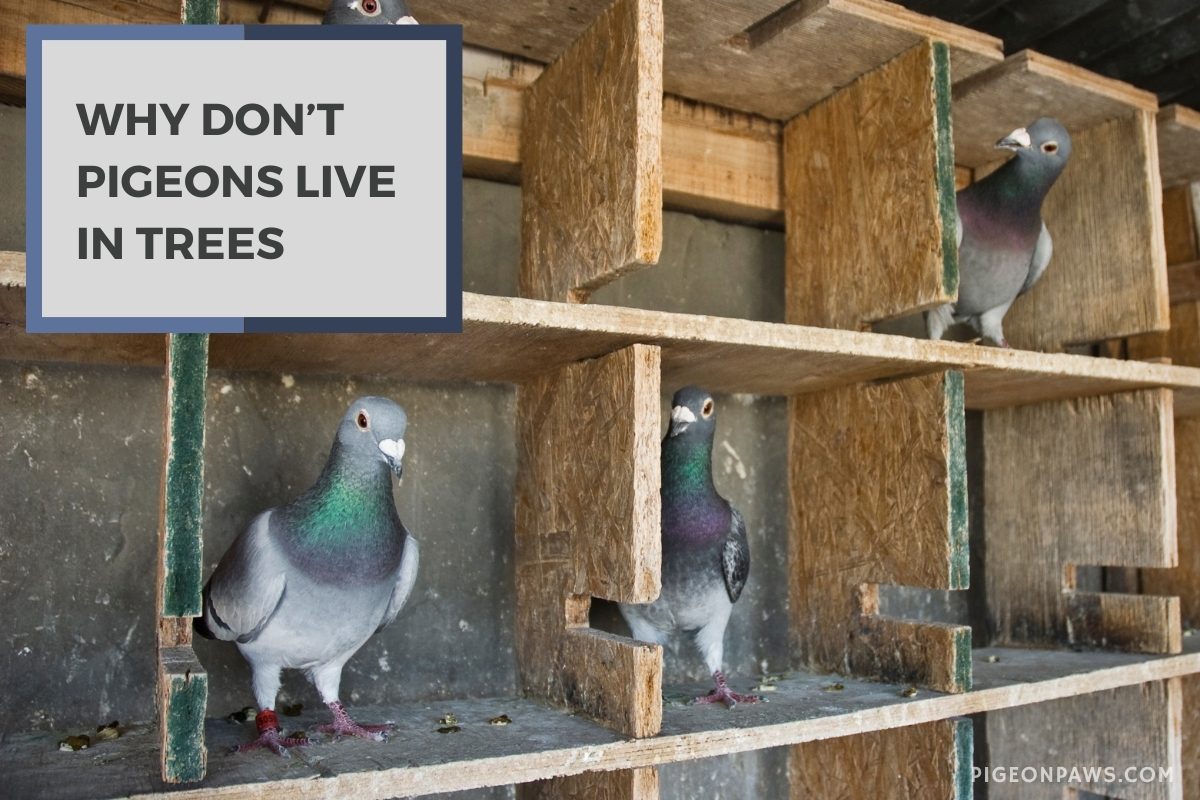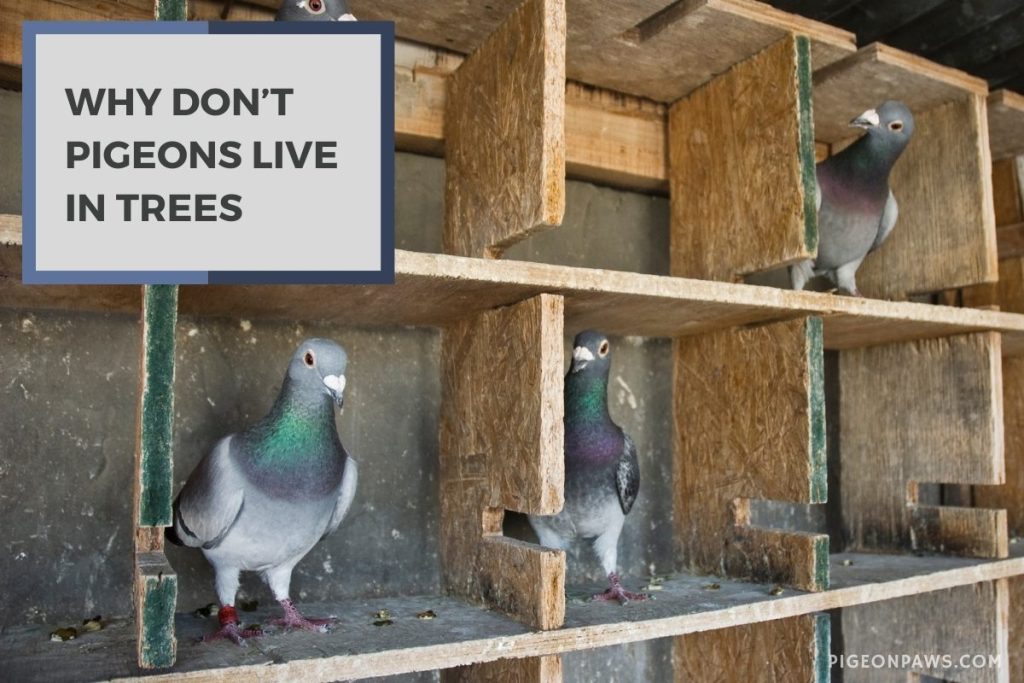Why Don’t Pigeons Live in Trees? The Reason They Avoid Trees

Pigeons, also known as rock doves, are a common sight in urban environments all around the world. They are known for their distinctive cooing calls, unique color patterns, and ability to thrive in a variety of habitats. One interesting behavior of pigeons is that they generally avoid living in trees.
These birds like to stay on the ground rather than in trees. They like to be together in open spaces and rooftops because it is easier to find food and safer from predators. Trees don’t have the same kind of nesting materials as the ground.
In this article, I’ll delve into pigeons’ natural habitat and the factors contributing to their tendency to avoid trees. Join me as I explore these topics in greater detail.

The Reasons Why Pigeons Do Not Prefer Trees As A Habitat
Despite being a common habitat for many bird species, trees are not typically a preferred habitat for pigeons. There are several reasons why these birds tend to avoid trees and instead choose other environments to live in.
Lack of Nesting Sites
One of the main reasons why pigeons do not prefer trees as a habitat is the lack of suitable nesting sites. They typically build their nests out of twigs, grasses, and other materials, requiring a flat surface to do so.
Trees often lack this flat surface, making it difficult for pigeons to build their nests. Besides, the leaves and branches of trees can make it difficult for them to access their nests and care for their young.
Risk of Predation
Trees are often home to various predators, including birds of prey and snakes, which can make it dangerous for pigeons to nest in them. Also, the branches and leaves of trees can make it difficult for pigeons to escape from predators or hide from view.
Limited Food Sources
Pigeons usually do not find ample sources of food in trees, which can also make them less desirable as a habitat. They usually feed on seeds, grains, other plant materials, insects, and small animals.
Trees may provide some of these food sources, but they are not typically as abundant or easily accessible as in other habitats, such as open grasslands.
What Are The Natural Habitats of Pigeons?
These feathered creatures are known for their ability to adapt to a wide range of environments, from bustling urban areas to remote wildernesses.
Now, I will explore the different types of habitats where pigeons are found and their unique characteristics.
Urban Habitats
Pigeons are perhaps most commonly associated with urban environments. They often nest on ledges, rooftops, and other man-made structures.
This is because cities provide a steady supply of food and shelter for these birds, allowing them to thrive in even the most densely populated areas.
Despite their ubiquity in cities, they still face many challenges, such as pollution, disease, and human interference.
Rural
While pigeons are typically associated with urban areas, they can also be found in more rural environments. These birds can be seen in fields, barns, and other agricultural areas where they feed on grains and other crops. In these environments, pigeons face different challenges, such as predation from hawks and other birds of prey.
Coastal
Pigeons are also found in coastal habitats, where they feed on marine invertebrates and other small organisms. These birds are often seen on beaches, piers, and other coastal structures. In these environments, they face challenges such as storms and harsh weather conditions.
Forests And Woodlands
While pigeons do not typically inhabit trees, they can be found in forested areas where there are clearings and open spaces. They forage for seeds and berries on the forest floor in these habitats.
Do Pigeons Not Fly Away Because They Prefer to Stay on the Ground or in Urban Areas Instead of Trees?
Do pigeons not fly away because they prefer to stay on the ground or in urban areas instead of trees? The secret lives of pigeons reveal the answer. These birds have adapted to urban environments, finding abundant food and shelter in cities. While they may spend more time on the ground, pigeons are capable of flying and utilize it for short distances.
Are There Any Pigeon Species That Live in Trees?
While pigeons generally do not prefer trees as a habitat, there are some species that have adapted to live in trees for at least part of their lives.
Fruit-Doves
The pigeon species known as fruit-doves is distinguished by its vividly colorful plumage and affinity for fruit as a dietary source.
Typically, you may find these birds in tropical and subtropical forests, where they make use of trees for both roosting and nesting.
They can find plenty of food supplies in the form of fruits and berries on the trees where they live, which makes them well-suited to this habitat.
Nicobar Pigeons
Another pigeon species known to live in trees is the Nicobar pigeon. These birds are found on islands in the Indian and Pacific Oceans and are known for their distinctive iridescent feathers.
They typically nest and roost in trees, using their strong legs and feet to grip branches and powerful wings to navigate the dense forest canopy.
Wood Pigeons
Although Wood Pigeons are typically found in more open woodland areas rather than dense forests, these birds are often seen perched on tree branches or foraging for food in trees.
They are able to find food sources such as acorns and other nuts in the trees where they live, making them well-adapted to this habitat.
Conclusion
While many bird species make their homes in trees, pigeons generally do not prefer this habitat. They require flat surfaces for nesting, are at risk of predation in trees, and do not typically find abundant food sources in this environment.
However, some pigeon species, such as fruit doves, Nicobar, and wood pigeons, have adapted to living in trees for at least part of their lives. They are incredibly adaptable birds that can thrive in various environments.
While they may not prefer trees as a habitat, they can live and thrive in urban areas, rocky cliffs, woodlands, and other environments. Understanding pigeons’ natural habitat and behavior can help us appreciate these fascinating birds and better protect their populations for future generations to enjoy.

